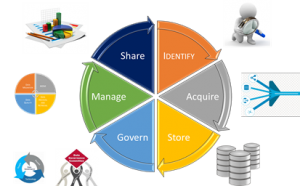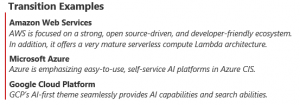As Gartner predicted, artificial intelligence is emerging as a core business and analytical competency. Although information is still not recognized as a line item in a corporate balance sheet (data as an asset), it is still a strategic asset that can drive business value. Therefore, it’s important to have data strategy framework in place.
On a daily basis, I come across clients looking for a data strategy. In their minds, it’s a collection of enterprise data assets that are put in a spreadsheet and organized with a determined future state. While this is partially true, there are a few components missing.
Data Strategy Components
A simple definition of data strategy is to identify a plan to acquire, store, share, use, and govern data as an enterprise asset.
Another important aspect is to identify technology enablers of a data ecosystem. This includes reporting tools, data science toolkits, MDM, EDW technologies, big data, content management, and search platform.
It’s important to note that within the next couple of years modern BI analytics platforms might offer toolkits that will provide all of the above capabilities in a single, NLP-driven platform. Gartner predicted that 50% of analytics queries will be generated using search, natural-language query/voice, or will be auto-generated by 2019. This proves that analytics, data science, machine learning, and artificial intelligence are becoming a blended capability.
After making these identifications you can address the four key components that will help formulate a strategy: Centralization, Action, Relevance, and Evolution (CARE).
CARE Framework
When developing a data strategy we like to use CARE to build the framework. The four questions below are what we need to ask at an enterprise or line of business level to produce a strategy with tangible return on investment.
Centralized – Is the data centralized and connected to business objectives?
Actionable – Can the data provide actionable goals and tangible KPIs?
Relevant – Is the data relevant and unique to the organization and not a generic dataset (ex. weather, traffic, zip code)
Evolutionary – Is the data expected to change over time or is it static?
Answering these questions will help address your enterprise’s data potential and set forth a viable plan-of-action. Having a solid data strategy will positively affect your organizations success and likely put you ahead of the competition.
Need help building your strategy framework? Reach out to our Data Solutions experts for more information.



